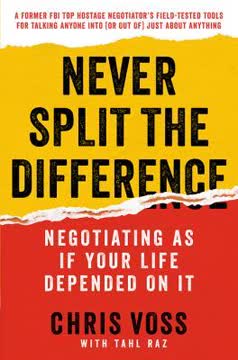Key Takeaways
1. Active Listening 2.0: The Art of Extracting Meaning and Intent
Active Listening 2.0 goes beyond to just listening. 2.0 requires a salesperson to become skillful enough to extract the meaning and intent behind every question and statement shared by the prospect.
Redefining active listening. Active Listening 2.0 is not just about hearing words, but understanding the deeper meaning and intentions behind them. This advanced technique involves:
- Paying full attention to the speaker
- Responding appropriately
- Remembering key points
- Understanding the message completely
Practical application. To implement Active Listening 2.0:
- Ask the right questions at the right time
- Use assumptive statements to encourage prospects to open up
- Avoid yes-no questions that limit responses
- Employ awkward silence to prompt further discussion
By mastering this skill, salespeople can uncover crucial information, build trust, and guide the conversation towards a successful sale.
2. Establish Clear Rules of Engagement for Effective Sales Meetings
If you fail to determine the agenda of the meeting, both parties may end up wasting time on trivialities that do not contribute to overall success.
Set the groundwork. Establishing clear rules for sales meetings is crucial for productive encounters. This involves:
- Defining the purpose of the meeting
- Setting a reasonable duration (1-1.5 hours)
- Outlining the agenda and expected outcomes
Key strategies:
- Ask for permission before stating the meeting's purpose
- Use simple language that a third-grader could understand
- Write down questions asked by the prospect
- Request permission before asking personal questions
By setting these ground rules, you create a structured environment that fosters trust and facilitates effective communication, ultimately increasing the likelihood of a successful sale.
3. Uncover Pain Points and Motivations to Drive Sales
Buying decisions is an emotional process. For many people, they buy first before thinking about the consequences.
Emotions drive decisions. Understanding and addressing a prospect's pain points and motivations is crucial for successful sales. To uncover these:
- Listen actively for clues about their challenges
- Ask open-ended questions to encourage elaboration
- Use empathy to connect with their emotional state
Practical techniques:
- Share relevant testimonials to build trust
- Use analogies to help prospects visualize solutions
- Avoid assuming you know their situation; always seek clarification
By focusing on the prospect's emotional needs and pain points, you can position your product or service as the ideal solution, increasing the likelihood of closing the sale.
4. Master the Money Dance: Navigating Price Negotiations
I like to refer to the stage of uncovering price as the Money Dance. This is actually because both parties will go back and forth on negotiations in almost like a dance pattern.
Choreograph your approach. The Money Dance requires finesse and strategy. To navigate price negotiations effectively:
- Use the family approach: Ask if they've discussed an acceptable price with family or friends
- Provide a price range based on competition to gauge their expectations
- Employ the "off the record" technique to encourage openness
Key considerations:
- Be flexible but ensure the price is reasonable for both parties
- Investigate factors that may affect their pricing and payment ability
- Remember that if the price is right, the deal is closer to being done
By mastering the Money Dance, you can uncover the prospect's price expectations and work towards a mutually beneficial agreement.
5. Timing is Everything: Strategically Uncover the Prospect's Timeframe
Too much time can be dangerous too because they could change their decision before final negotiations are put to bed.
Balance is crucial. Uncovering a prospect's timeframe requires tact and strategy. To do this effectively:
- Assume a long timeframe initially; prospects will correct you if they want something sooner
- Share testimonials of similar clients to break uncertainty loops
- Avoid pressuring prospects into hurried decisions
Key strategies:
- Use indirect questions to uncover timing preferences
- Be prepared to work with flexible timelines
- Ensure the timing aligns with delivering value to the prospect
By skillfully uncovering and managing timeframes, you can create urgency without pressure and move the sale forward at a pace comfortable for both parties.
6. Identify Decision Makers Without Using the Word "Decision"
Without using the word decision, how do you find out who the decision maker is?
Rephrase your approach. Identifying decision-makers without triggering defensive responses requires finesse. Use these alternative questions:
- "Who else has input on this matter?"
- "Who else will be impacted by this?"
- "I assume nobody has veto power."
Key strategies:
- Focus on finding influencers, not just the ultimate decision-maker
- Ask to speak with other stakeholders to address their concerns
- Welcome input from family members or advisors to build trust
By avoiding the word "decision" and approaching the topic indirectly, you can uncover the true decision-making process without putting prospects on the defensive.
7. Confirm Terms and Close with a Natural Conclusion
Do you want my help?
Simplify the close. Confirming terms and closing the sale should feel natural and straightforward. Follow these steps:
- Review established rules and previous agreements
- Recap the prospect's pain points to reinforce motivation
- Confirm the agreed-upon price
- Review all stakeholders involved in the decision
The natural conclusion close:
- Use the simple five-word question: "Do you want my help?"
- If met with hesitation, probe gently to uncover any lingering concerns
By systematically reviewing all aspects of the sale and ending with a simple, direct question, you create a natural path to closing the deal.
8. Prevent Buyer's Remorse by Building a Fence Around Your Prospect
Until the money from a sale is in your bank account, you must work to keep the prospect engaged in the sale, even after the contract has been signed.
Stay vigilant post-sale. Preventing buyer's remorse is crucial for ensuring the sale is completed. Implement these strategies:
- Reinforce the meaning of the sale by asking what the contract means to the prospect
- Give the option to cancel early, reducing the likelihood of later backouts
- Prepare prospects for objections from family or friends
Key tactics:
- Roleplay potential conversations with objectors
- Provide reasons to counter competitor approaches
- Maintain contact and engagement until the money is in the bank
By building a protective "fence" around your prospect, you safeguard against outside influences and keep the sale on track to completion.
9. Implement a Scorched Earth Policy to Protect Your Sales
If you are familiar with our business and our policy, then you understand that if we're not getting the contract, nobody's getting the contract.
Strategic protection. The Scorched Earth Policy is a powerful tactic to protect your sales when you can't close the deal. Here's how to implement it:
- Develop 2-3 unique selling propositions (USPs)
- If the sale isn't progressing, inform the prospect you can't help them
- Ask them to write down your USPs and insist future vendors match them
Key benefits:
- Creates doubt about competitors' abilities
- Increases the likelihood of prospects returning to you
- Protects your market position even when you don't win the sale
By strategically "planting landmines," you make it difficult for competitors to win over your prospects, potentially bringing them back to you.
10. Cold Calling: Mastering the First Crucial Seconds
During a cold call, you need to attract the attention of your prospect within the first few seconds of the call.
First impressions matter. Cold calling success hinges on those initial moments. To make them count:
- Introduce yourself clearly and concisely
- Quickly state the purpose of your call
- Have a compelling opener that grabs attention
Preparation is key:
- Research your prospect beforehand
- Prepare a script but sound natural
- Be ready to handle common objections
Remember, cold calling isn't limited to phone calls. The same principles apply to cold emails, social media outreach, and door-to-door sales. By mastering these first crucial seconds, you significantly increase your chances of progressing to a meaningful conversation and potential sale.
Last updated:
Review Summary
Active Listening 2.0 receives mostly positive reviews, with an average rating of 4.13 out of 5. Readers appreciate the practical advice and useful information for those in sales, particularly for both newcomers and experienced professionals. The book is praised for its concise nature and breakdown of common situations in sales conversations. Some readers found it valuable as a starting point but desired more in-depth knowledge. However, a minority opinion suggests the book lacks substantial content and recommends looking for alternative resources.
Similar Books
Download PDF
Download EPUB
.epub digital book format is ideal for reading ebooks on phones, tablets, and e-readers.









